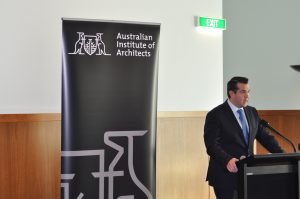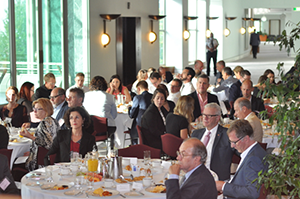On 22 March, the Institute hosted a housing affordability briefing at Parliament House in Canberra to examine the issues of density, design and the challenges ahead. The Institute’s National Councillors and Executives joined more than fifty Members of Parliament, Senators and their Staff including Assistant Minister to the Treasurer, the Hon Michael Sukkar MP as National President Prof Ken Maher addressed the audience.



SPEECH
PARLIAMENT HOUSE
CANBERRA 22 MARCH 2017
Professor Ken Maher LFRAIA
President, Australian Institute of Architects
Good morning and I would like to add my welcome on behalf of the Institute’s National Council. Thank you for attending this morning and joining our discussion on the housing challenge facing our nation. As architects our focus is on the significant contribution design can make to the provision of better, more sustainable and more affordable housing for everybody.
Growing up in Australia during the latter half of the 20th Century was a time of optimism and aspiration. ‘The Great Australian Dream’ – the notion that home ownership could lead to a better life – not as a dream, but as a realistic expectation; if you had a job, you too could live the dream of a detached house on a quarter acre block with a backyard, a BBQ and a Hills Hoist. It is also important to remember there was a small but growing demand for what were termed ‘flats’ and terrace houses – the beginning of diversity with some of Sydney best flats built for war widows.
As recently as 1990, this optimism was still well placed – the average price of a house in Sydney was $157,000… cheaper in other parts of Australia. Twenty-seven years later, it is a very different story. Depending on which survey you use, the median house price in Sydney now sits just below or just above the magic million dollar mark. And, to be clear, these are not McMansions. Last year in Sydney, a burnt-out shell of a home sold for $1.4 million. In Melbourne, the median price is a little lower, but still nudging $800,000. Even in Australia’s cheapest capital city, Hobart, which was once seemingly immune to the property boom, prices have rapidly escalated in recent years, with the median price now hovering close to $400,000.
With rising prices locking many first home buyers out of the market, the rental market is no better. Low to moderate income earners also face increased private rent prices, along with short tenure and a lack of supply. This is exacerbated by Australia’s rapidly ageing population. As the last intergenerational report showed, the 40 year horizon is one of a nation where the proportion of the population aged over 65 will be more than double what it is today. Not to mention the one in a thousand people who will be aged over 100. And this means a dramatic change in the type of housing needed.
None of this information is new or surprising – Australians are so familiar with the narrative that, in the National Australia Bank’s recently released report Life in the “Lucky Country” What Makes Australia Great?, 88 per cent of Australians were more pessimistic about the future of housing affordability and living costs than any other lifestyle factor in the next ten years.
So what can be done to tackle the problem? There can be no doubt that it is a complex issue, with flow-on effects to the economy, changing family profiles and changing values. None of us can claim to have the silver bullet, there is no easy answer, no ‘one size fits all’. On the supply side compounding suburban sprawl is unsustainable. We need to make better use of existing stock through inventive retrofitting to suit current demographics.
In the growth of our cities new housing stock needs careful integration with transport and social infrastructure and much greater diversity beyond simple models of homogenous suburban ‘boxes’ or regimented apartments so readily delivered by our development industry if unregulated. Architects have been aware of this issue for a long time and proposing innovative design solutions. Most recently in Sydney Rob Stokes, the then NSW Planning minister, proposed encouraging terrace type housing in the middle ring suburbs as one way of increasing both density and diversity.
What is clear is that it requires a coordinated response from governments, developers and industry. Agreements between Commonwealth, state and territory governments, are an important start, promoting investment in affordable housing. But governments need also to be using financial levers through incentives to the development sector in return for the delivery of housing diversity and affordability, along with incentives to encourage compliance beyond the minimum requirements. Planning regulations need to be modified and harmonised to introduce clear targets for social and affordable housing, including more flexible housing types and multi-generational occupancy.
And this doesn’t stop with housing – housing affordability goes beyond the price of a house and expenditure on electricity, gas and water. If we really are serious about tackling this growing problem, we need to also take into account access to employment, education, services and facilities. We need communities where there is less reliance on cars, better public transport connections, where density in the urban environment is well designed, where infrastructure investment supports strategic planning and where communities are connected and brought together in a way that enhances liveability, sustainability and productivity.
Budget and infrastructure constraints mean that expanding ever outwards is not a sustainable option. Already, many Sydneysiders face average daily commute times of 71 minutes and, for three out of ten residents, it tops 90 minutes. A long way from the 30 minute city! This is not the way of life we want. The Grattan Institute report, City Limits, observes Australian cities are nearing their limits and planning policy and housing provision needs to adjust to changing patterns of work.
There are compelling social reasons to change planning policy. People living in inner cities have much better education levels, access to jobs, and high incomes. The divide is increasing, and is particularly disadvantaging women- no work and no super as women age. Poor access to jobs leads to poor social outcomes. In outer suburbs people earn lower incomes on average, and are more likely to be employed on a casual basis. It is harder for women caring for children in outer areas to participate in the workforce. Obviously, longer commuting times result in higher living costs of thousands of dollars a year, placing pressures on family life and lowering well-being.
Recent interest by the Commonwealth through the Cities Portfolio under Minister Angus Taylor are to be welcomed in ensuring infrastructure investment and planning is integrated with the provision of housing in the growth and densification of our cities.
The current work of the Greater Sydney Commission (partly modelled on Perth’s Metropolitan Planning Authority) to integrate city planning across state and local governments is to be applauded and could well be promulgated nationally through the influence of the federal government.
The demand side can also be addressed through more holistic thinking, including strategic planning for the investment in a fast train network improving access to our major cities from regional centres as has been proposed by John Alexander MP and his Standing Committee on Infrastructure, Transport and Cities.
As architects we must resist the temptation to advise on fiscal policy, however it is clear that with the depth of the current housing challenge it is time for a major policy overhaul with all measures on the table including stamp duty, land tax, capital gains tax, and negative gearing to ensure policy levers are effective.
These measures can all contribute to improved housing options, including affordability. But it is also critical to ensure that the notion of affordability takes into account the ongoing costs of occupation including energy, transport, adaptability and life span.
In this regard one of the most important contributions to the delivery of affordable housing is often the most overlooked – the contribution of architecture. Up until the 1970s governments and the architecture profession worked together, providing medium density housing to both private and public housing sectors. We have seen the retreat of government investment, with developments now predominantly driven by the bottom line.
While it may be tempting to look for initial savings by opting for the cheapest proposals, we have entered a time when the government-architect partnership needs to be revisited. As a key player in the development of the built environment, the architecture profession has the skills to deliver housing that addresses crucial issues, such as affordable living, sustainable design and flexible housing, providing savings in both upfront costs and the ongoing cost of occupation.
Increased density needs to be a core part of the housing solution and proper planning and design are crucial to ensuring that density is done well. To this end, nationally consistent design quality programs are needed for multi-residential developments, modelled on New South Wales’ State Environmental Planning Policy Number 65 – Design Quality of Residential Apartment Development…better known as SEPP 65. Three key aspects of SEPP 65 make it so successful in delivering quality housing; a strong and effective design code, the mandated use of architects in multi-residential buildings, and peer review by design practitioners with experience in the design of multi-residential buildings.
Planning policy has major well-recognised impacts on economic policy. The need for low-rise, medium density housing has been discussed by governments for many years and the NSW Office of Government Architect has recently conducted the ‘Missing Middle Competition’ seeking high quality, innovative design solutions for low-rise medium density housing including detached and attached dual occupancy, terraces and townhouses to bridge the gap between inner city high rise apartments and outer fringes low density housing. These are generally more affordable because they require less land. They are sustainable and if designed well, they can create stronger and healthier communities and contribute to our cities resilience in the future.
There are many examples of the innovations used by architects in designing mass housing to deal with contemporary challenges. The Melbourne apartment development The Commons by Breathe Architecture is a project that won the Institute’s top multiple housing award in 2014 and which charts a new direction in medium-density living, demonstrating how singles, young families and retirees alike can comfortably and sustainably live a rich life in our expanding cities. This apartment complex eliminated what ‘the market’ insists is necessary in multi-residential design: car parking, sumptuous materials and finishes, and air conditioning. The approach was positively reductive, questioning what was really essential, and is now continuing around the country as Nightingale Housing, supporting wellbeing, community and liveability.
The Architectus-designed Platform Apartments in Sydney is another example of excellence in the delivery of affordable housing. The project won UDIA’s NSW Affordable Development Award in 2015. Janelle Goulding, the CEO of City West Housing noted the design provides tenants with maximum comfort and flexibility that has changed people’s perspective of what affordable housing is.
An example from my personal experience is Common Ground Sydney, an initiative by Housing NSW and Mission Australia Housing based on a model from housing the homeless from New York in the 1990s. Architects HASSELL collaborated with developer and builder Grocon, providing housing with naturally ventilated individual rooms, all with balconies and supported by common facilities and street-front community services. Common ground projects have also been built in Adelaide, Melbourne, and here in Canberra.
For lower density housing, improved building techniques and the innovative use of standard building materials can also have a positive impact on affordability. We are now at a point where prefabrication and mechanisation of the building industry is coming of age. We’ve all seen those tiny homes made out of shipping containers. Last year, Sydney architect Alexander Symes unveiled his design for what was described as Australia’s first flat-packed, off-grid tiny home, created by his project Big World Homes. These portable, modular homes, selling for under $80,000, each comprise a living room, bed, plumbed bathroom, with running water from inbuilt rainwater tanks and electricity from solar panels. These homes demonstrate what is possible when creative minds take a fresh look at recurring problems. Many architects are innovating with design proposals for kit and project homes coming to the market which can be a game changer for affordable housing.
As Australia’s population centres, cities and towns have drawn most of the focus in the affordability debate. But regional areas are not immune, and the problems are even more acute in remote Indigenous communities. Increasingly architects are turning their attention to these issues bringing an inventiveness to producing housing that is appropriate to particular cultural practices and relationships, and the demands of geography and climate.
The work of the late Paul Pholeros is an outstanding example – Paul dedicated much of his career to helping to improve the living conditions of Indigenous communities, through the design, development and improvement of housing in these areas.
His premature loss last year was a huge blow to these communities, precisely because of the enormous contribution he had made. What a tribute it would be to his legacy to ensure his work lives on, through federal government mandating use of architects in these critical social and cultural projects as a condition of funding.
With buildings accounting for almost a quarter of our carbon emissions, the building sector must achieve major improvements if Australia is to meet its international obligations under the Paris Climate Change Agreement. The Australian Sustainable Built Environment Council’s (ASBEC) Low Carbon High Performance report address key ways in which the design of buildings can deliver outcomes and identifies changes to provisions in the stringency of the NCC residential standards by 2019 that are critical to this. The architecture profession is well placed to help achieve these reductions, with more energy and cost-efficient mass housing at the top of the list.
We need to recognise the value good architecture brings to achieving cost-effective and sustainable buildings and urban centres, which contribute to the sustainable growth of our communities, economy and culture. In short, good design can’t be seen as a luxury or an optional extra; rather, it is essential to delivering a built environment that can sustain Australia’s diverse communities into the future. Indeed research conducted in 2015 by Galaxy Research for the Architects Accreditation Council of Australia found that almost all Australians – 97 per cent in fact – believe that cities and towns are better to live in when public buildings and public spaces are well designed.
The magnitude of the housing affordability challenge facing Australia means efforts to combat it is a task shared by all levels of government and all sectors of industry. You here in our national parliament are uniquely placed to help harness the ideas and expertise on offer in pursuit of a solution to protect the Australian way of life for generations to come
The Institute believes that all Australians should have the opportunity to live in well-designed housing. To achieve this government intervention is now necessary where there has clearly been market failure. We strongly support the objectives of the Smart City Plan, City Deals, the National Cities Performance Framework, and the setting up of the Cities Reference Group – which we hope to be part of. Holistic city planning and design needs to lead investment in physical and social infrastructure to build strong communities.
To finish I am reminded that architects are optimists. I suspect the same is the case for politicians. We want to make a difference – we want to change the world. We want it to be a better place as a result of our efforts. Architects deal with the physical and experiential. For us the most important thing is to translate this optimism into action – otherwise there will be no real change.
We can make a difference through design, and want to work with you in addressing one of the most critical challenges of our time: affordable, amenable and sustainable housing underpinning strong communities. This can re-engender a sense of confidence in the future of our wonderful country.
Thank you.



